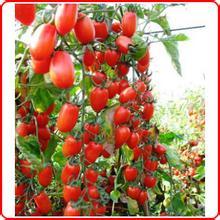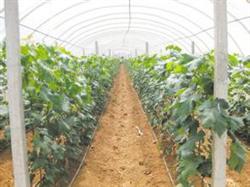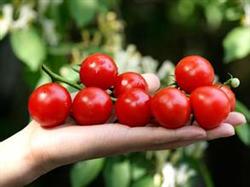Cultivation techniques of Virgin Fruit of small Tomato

1. In the northern part of the cultivation season, the seeds were sown from mid-September to early January of the following year, and harvested from the end of December to the middle of May of the following year; in the southern region, the seeds were sown from late August to mid-December and harvested from late November to April of the following year. Second, select varieties that are disease-resistant, heat-resistant, high-quality, high-yield, resistant to storage and transportation, good in merchandise and adapted to the market. Recommended varieties: Yazu No. 6, Cuihong, Longnu, Red Queen. 3. Seedling raising techniques 1. Preparation before raising seedlings (1) Seedling raising facilities: according to different climatic conditions, select seedling raising facilities such as plastic shed or ordinary cold bed, popularize the use of point tray seedling raising technology, and disinfect seedling raising facilities. create environmental conditions suitable for seedling growth and development. Plastic shed: sagittal height 0.5 m-0.6 cm, span 1.2 mi 1.5 m, unlimited length. Seedling plate: there are 100 holes in 72mur. the length, width and height of the plate are 55 cm × 35 cm × 7 cm. (2) nutritious soil: according to local conditions, select field soil without disease and insect source, grain hull ash or coconut bran, mature farm manure and sandy soil to prepare nutritious soil at 6:3:1. Porosity is required to be about 60%, available phosphorus 100mg/kg above, available potassium 100mg/kg above, available nitrogen 150mg/kg above, PH6-7. Loose, fat conservation, water conservation, complete nutrition. The prepared nutrient soil was evenly spread on the seeding bed with a thickness of 10 cm and loaded into a seedling hole plate. (3) seeding beds: prepare sufficient seeding beds in accordance with the planting plan. The sowing bed was disinfected by spraying the bed soil with 1000 times solution of soil bacteria. The seeding bed is generally 150 cm wide, 25cm high and unlimited in length. 2. Seed treatment (1) Disinfection treatment selects the following disinfection methods according to the main local diseases. A) soak the seeds in warm soup and soak the seeds in 55 ℃ warm water for 15 minutes, then soak them in warm water for 6 hours. Mainly control leaf mildew, canker and early blight. B) soak the seeds with trisodium phosphate for 5 hours, then soak them in 10% trisodium phosphate solution for 20 minutes, remove and wash. Mainly to prevent and cure virus. (2) the seeds after germination and disinfection were removed and washed, and then germinated under the condition of 25 ℃-28 ℃ heat preservation and moisture preservation. 3. Sowing (1) sowing date: the suitable sowing time is selected according to the cultivation season, climatic conditions, seedling raising methods and strong seedling index. (2) seed quality: it meets the requirements of grade 2 or above in GBI6715.3-1999. The specific requirements are: seed purity ≥ 95%, purity ≥ 98%, moisture ≤ 7.0%. (3) seeding rate: according to the seed size and planting density, the general amount of seed used in the field is 3mur4g per mu. (4) sowing method: when the germination seeds are more than 70% white, they can be sown, or they can be directly sown after disinfection. Pour sufficient bottom water before sowing and moist to the depth of the bed soil 10 available phosphorus 100 cm. After the water seeps down, spread a thin layer of nutritious soil, including the surface of the bed, and sow seeds evenly. Each square meter of seedling bed with 8 grams of 50% carbendazim wettable powder or 8 grams of 70% pentachloronitrotoluene wettable powder mixed with dry fine soil are scattered thinly on the bed surface to prevent sudden collapse. After sowing, the nutritious soil is 0.8 Mal 1.0 cm. Pot seedlings were first watered through the substrate, and the sowing depth was 0.8mur1.0 cm. Cover plastic film, sunshade net or rice straw according to climatic conditions, and remove 70% of the top soil of seedlings. 4. Seedling stage management (1) Environmental control a) temperature: the high temperature mainly depends on the sunshade net to cool down. Use plastic shed for management at low temperature. The optimum daily temperature is 25 ℃-28 ℃, and the optimum night temperature is 17 ℃-20 ℃. B) Water and fertilizer: proper control of moisture after emergence. The two leaves of the seedlings were combined with the condition of the seedlings and applied the fertilizer 2MUE for 3 times. It is mainly 0.1%-0.3%NPK compound fertilizer. (2) the index of strong seedling is 4 leaves, the plant height is 15 cm, the stem diameter is about 0.4 cm, and the seedling age is about 25 days. The leaves are dark green and free from diseases and insect pests. 4. Planting 1. Prepare before planting (1) apply basic fertilizer for soil preparation. The amount of general base fertilizer: more than 80% of the total amount of phosphate fertilizer and 20% of the total amount of nitrogen and potash fertilizer. Apply high-quality organic fertilizer (organic matter content more than 9%) 1500ml 2000 kg per mu. When the independent variable of nutrients is insufficient, it is supplemented with chemical fertilizer, which is sprinkled with quicklime 50m / mu, high-quality cake fertilizer 30m / m ~ 40kg, and high quality phosphate fertilizer 30m / mu. These fertilizers must be fully ripened and fermented, of which 2 beat 3 combined with soil preparation, turning 25ml 30 cm deep, and the other 1 hand 3 should be applied into the planting ditch (hole). Make beds according to local planting habits. The general width of the bed is 160ml 180cm (covering trench). (2) mulching plastic film: select plastic film according to the width of the border. Generally choose a black mulch with a thickness of 0.02 mm and a width of 120 mi 130 cm. The plastic film is laid flat on the border and pressed around the film with dry fine soil to prevent the wind from lifting the film. 2. The planting method and density should be planted in large and small rows or single rows according to the planting specifications. According to the variety characteristics, pruning methods, land characteristics, climatic conditions and cultivation habits to determine the plant distance, generally planted 1200mur1600 plants per mu. Planting should be shallow, pay attention to more nutritious soil, quick pouring root water, plastic film planting hole should be sealed strictly.
- Prev

Pesticide control methods for common diseases of grape in greenhouse
Pesticide control measures for all kinds of diseases of grape in greenhouse: prevention and control of grape downy mildew: clean the orchard, spray 5 Baomedu stone sulfur mixture before sprouting, spray once every half a month from the young fruit stage, and spray 40% Trichoderma 800 / 1000 times when you get sick. Prevention and control of grape white rot: clean the orchard, every from June.
- Next

Techniques of early planting of fresh virgin fruit in spring
Virgin tomato, native to Taiwan, is a kind of cherry tomato, mainly to eat fresh fruit, to be called virgin fruit. Early cultivation in spring, you can use a plastic greenhouse with a span of 6 meters, raise seedlings in the middle of November, plant in February of the following year, harvest fresh fruit in early May, and produce 6000 kg of fresh fruit per mu. First, seed treatment. ...
Related
- Moge, come on! The staff of the peasant association in the producing area of cantaloupe were frightened when the crowd gathered.
- Causes and Solutions of low Fruit setting rate of Apple
- Symptoms and control measures of passion fruit virus disease
- Fruit growing lesson: how do apple orchards keep high yields?
- Can you build orchards in the mountains? What are the pros and cons?
- How to manage the coloring period of Crisson grape?
- This paper introduces the processing technology of two kinds of fig products.
- How much is a month for retired teachers in rural areas by 2020?
- How can strawberry planting increase sugar content? We should pay attention to management in many aspects.
- What are the cultivation techniques on how to improve the yield of golden fruit?

